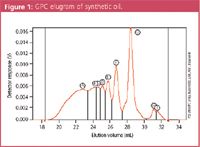"Polymer Status" of Synthetic Oil Under REACH Context
The Application Notebook
Under the registration, evaluation and authorization of chemicals (REACH) Regulations (EG) no. 1907/2006 the producer, manufacturer or importer of chemical substances/formulations have to register their products (more than 1 ton/year) at the chemical agency.
Friedhelm Gores, PSS Polymer Standards Service GmbH, Mainz, Germany.
Under the registration, evaluation and authorization of chemicals (REACH) Regulations (EG) no. 1907/2006 the producer, manufacturer or importer of chemical substances/formulations have to register their products (more than 1 ton/year) at the chemical agency.
For the registration a technical dossier is required. Producer or importer of chemical substances in a quantity of more than 10 ton/year is committed to give more information about the effect of the human health and environment.

Figure 1
Polymers are substances in the context of REACH; however, polymers are defined in REACH under article 3, No.5, as "special" substances, based on their composition and structure.

Table 1: Mass fraction of oligomers in synthetic oil.
Polymers are macromolecules that are synthesized by the reaction of an initiator (reactant) and monomers. During the polymerization process polymer chains grow with different chain length. Even if the average chain length is large there will be a fraction of either free monomer or of smaller chain lengths (oligomers). It is usually those fractions, which lead to any polymer toxicity.

Figure 2
Polymer Definition Under REACH
A polymer molecule is — in the context of REACH — a molecule that contains a sequence of at least 3 monomer units (M), which are covalently bound to at least one other monomer unit or reactant (initiator).
This definition is equal to the so called (3M+1)-rule.
a) Over 50 percent of the weight for that substance consists of polymer molecules.
b) The amount of polymer molecules presenting the same molecular weight must be less than 50 weight percent of the substance.

Determination of "Polymer Status"
The preferred method to identify whether a substance falls under the definition of a polymer is gel permeation chromatography (GPC). Guidelines on the determination of the molecular weight distribution using GPC are available in the OECD TG118 (1996).
Because GPC is a relative method, a calibration is required. Mostly narrowly, linear polystyrene molar mass standards are used for calibration.
The calibration curve can be used in the determination of the molecular weight of the unknown sample if the conditions for the separation of the sample and the standards are identical.
In the instance of oligomeric compounds a high separation capacity for small molecules is essential to get oligomer-peaks separation.
From the GPC elugram it is possible to calculate the molecular weight and the molecular weight distribution of the unknown sample using the slice-by-slice method. Furthermore, the relative mass content of oligomeric species can be calculated easily to proof the polymer status under REACH context.

Conclusion
The analysed synthetic oil is a polymer under REACH definition
Literature:
1. ECHA (European Chemicals Agency), Guidance for monomers and polymers, 2007.

PSS Polymer Standards Service GmbH
In der Dalheimer Wiese 5, 55120 Mainz, Germany
tel. +49 6131 962390 fax +49 6131 96239 11
E-mail: info@polymer.de Website: www.polymer.de

The Benefits of Custom Bonded Silica
April 1st 2025Not all chromatography resins are created equal. Off-the-shelf chromatography resins might not always meet the rigorous purification requirements of biopharmaceutical manufacturing. Custom bonded silica from Grace can address a wide range of separation challenges, leading to real performance improvements. Discover more about the latest innovations in chromatography silica from Grace, including VYDAC® and DAVISIL®.
5 Things to Consider When Selecting a Chromatography Silica
April 1st 2025Particularly in the pharmaceutical industry, drug purity isn’t just a goal – it’s essential for achieving safety, stability and efficacy. However, purification is easier said than done, especially with challenging molecules like DNA and RNA “oligonucleotides,” due in large part to their diversity and the range of impurities that can be generated during production. Enter DAVISIL® chromatographic silica, with a wide range of pore diameters and particle sizes to meet your specific application, performance and sustainability requirements. Before you choose the chromatography resin for your next purification application, take a look at these 5 considerations.
Automating Protein Purification: Efficiency, Yield, and Reproducibility
March 27th 2025Recent advancements in automated protein purification stress the importance of efficiency, scalability, and yield consistency. This eBook compares different purification platforms, highlighting their impact on downstream applications and demonstrating how automation enhances throughput and process control.
MilliporeSigma: Ultrapure Water for Sensitive LC-MS Analysis of Pesticides
March 25th 2025The aim of the study was to illustrate the efficiency of Milli-Q® water purification systems in eliminating pesticides from tap water, thereby producing and delivering reliable and consistent-quality ultrapure water suitable for pesticides analysis











